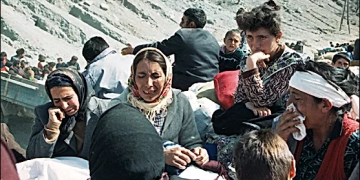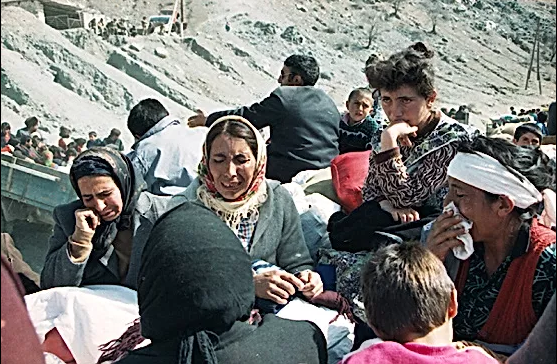Azer News
During the first Karabakh war (1988-1994), Armenia committed a series of systematic genocide acts against innocent Azerbaijanis. The Aghdaban massacre, which occurred a year before Armenian military forces occupied Azerbaijan’s Kalbajar region, is one of the bloodiest chapters in Armenia’s anti-Azerbaijan aggression. The village in Azerbaijan’s Kalbajar region was twice subjected to mass atrocities committed by the Armenian armed forces in the early 1990s.
During the massacre, the Armenian invaders committed horrifying atrocities, violating both military and international human rights principles by brutally murdering civilians and destroying all historical monuments in the village. As a result of the Aghdaban tragedy, which resulted in the burning of the entire village, hundreds of civilians were tortured and forced to flee their homes.
Scale of disaster
Aghdaban village lies 36 km northeast of the regional center, on the right bank of the Aghdaban river, on the slope of the mountain of the same name at the southern foot of the Murovdagh range. On the night of April 7-8, 1992, Armenian armed forces, with the support of the separatist Armenian gangs in the former Nagorno-Karabakh region, attacked Aghdaban and Chaygovushan villages. The residents scattered barefoot in the snow-covered forests and mountains, unaware of the onslaught. The people were left defenseless after the Armenians annihilated a small detachment defending the settlements.
Armenian Dashnaks stormed Aghdaban, utterly destroying over 130 homes and torturing 779 residents. They perpetrated genocide by killing innocent civilians in the most heinous manner possible, including the elderly, women, and children. Some 39 individuals were cruelly slaughtered in this catastrophe, including eight seniors aged 90 to 100, two toddlers, and seven women. In addition, two individuals went missing, 12 people were gravely hurt, and five people were kidnapped. Famous Azerbaijani poet Ashig Shamshir’s (1893-1980) residence and extensive archive were set on fire and reduced to ashes. This catastrophe also claimed the lives of 15 members of Ashig (Dada) Shamshir’s family. The Aghdaban massacre became Kalbajar’s darkest chapter. Armenian separatists, who were not punished for the Aghdaban tragedy, were plotting to occupy Kalbajar as a whole. On March 27, 1993, Armenian provocateurs invaded Aghdaban for the second time by besieging and razing it to the ground. The second occupation of Aghdaban meant the complete occupation of Kalbajar by Armenia. Kalbajar was besieged on all sides and completely occupied by Armenian armed forces on April 2, 1993.
Culturcide
The storming of Aghdaban had long been a goal for Armenians, not only as a strategic location but also as the birthplace of Kalbajar’s literary heritage. They did not merely perpetrate genocide in Aghdaban; Armenian bandits destroyed historical, architectural, and cultural monuments, as well as religious shrines and graves. They burned the manuscripts of poet Gurban (1859-1934) and his son Dada Shamshir, one of the masters of classical ashig poetry, who made unprecedented contributions to Azerbaijani literature and destroyed the entire artistic heritage of these great poets. The tragedy in Aghdaban was part of a large-scale genocide committed by Armenia against the Azerbaijani people. It would be unfair to use other words or terms to describe what the Armenian invaders did to demolish the community in one night.
Series of Armenia’s war crimes
Along with the Aghdaban village, Armenia committed multiple genocide acts against civilians, looted Azerbaijani settlements and destroyed its cultural heritage in the formerly occupied lands. The mass graves discovered in Karabakh’s different parts are vivid examples of war crimes committed by Armenian armed forces against the Azerbaijani people. Azerbaijan identified a burial place of civilians killed by the Armenian armed forces in Kalbajar region’s Bashlibel village during the first Karabakh war in the early 1990s. On April 18, 1993, the Armenian armed forces equipped with automatic and large-caliber weapons began firing on caves where helpless civilians were hiding. As a result, 12 unarmed persons (a 12-year-old child, a 16-year-old teenager, including six women and six men) were deliberately killed.
Prior to the Khojaly genocide, Armenians committed the worst tragedy in Khojavand region. The Garadaghli genocide was a stain on humanity, and heinous atrocities were committed in Akhullu, Tugh, Salaketin, and Edilli villages at the end of the 20th century. The tragic days in Khojavand villages started in 1988 when the Armenian separatist movement in Karabakh began. Garadaghli, Akhullu, Tugh, Salaketin, and Edilli fought valiantly against the Armenian invaders for several years. During those years, hundreds of villagers were killed in unequal battles with Armenian armed forces. The Khojaly genocide is seen as the pinnacle of the systematic crimes and atrocities committed by Armenia against Azerbaijanis.





